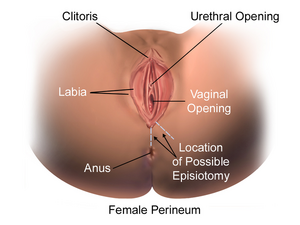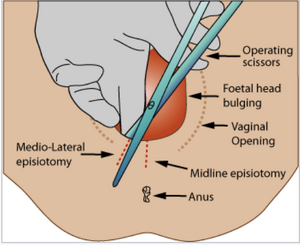Episiotomy
Episiotomy, or incision of the perineum, is the most common obstetric procedure. It is performed at the end of the second stage of labor. It is most often performed in primiparous women when cutting the head, because the perineum prevents its further progress and there is also a risk of rupture of the vaginal entrance (introit) and perineum.
Indication[edit | edit source]
The indication depends purely on the chosen procedure of the obstetrician and his discretion. It is based on the specific situation at the time of birth. There is no specific condition when to perform an episiotomy.
Types of episiotomy[edit | edit source]
Media[edit | edit source]
It is performed in the midline towards the anus up to a distance of no more than 3-4 cm on the perineum. It crosses the transversus perinei superficialis muscle.
Advantage – very easy suturing and very good healing.
Disadvantage – it is not suitable for a low perineum and for rapid resection of the head, when there is a risk of continued rupture and injury of the sphincter ani muscle.
Mediolateral[edit | edit source]
It goes from the midline of the introitus obliquely to the hump of the sciatic bone. It crosses the same muscles as a medial episiotomy, plus the bulbospongiosus muscle.
Advantage – there is less risk of damage to the sphincter.
Disadvantage – it bleeds more, sometimes it is harder to heal.
Lateral, obliqua, oblique[edit | edit source]
It starts 2–3 cm laterally from the center of the introit, continues like the mediolateral for a length of 4–5 cm to the ischial tubercle. It also crosses the bulbocavernosus muscle.
Advantage – the anal sphincter is the least threatened, it can best be extended towards the vagina and the perineum.
Disadvantage – it usually bleeds more, it is more demanding on suture and healing.
Extended lateral – Schuchardt incision[edit | edit source]
Schuchardt's incision is the only one performed with a scalpel. It has the same direction as the lateral episiotomy, but is slightly semi-arched and wider (6-7 cm). It is mainly used for forceps delivery. Iron
Technique[edit | edit source]
It is usually performed with the perineum fully developed and the cutting head at the peak of the contraction with special scissors with an external rounding and blunt end of one branch. The cut is made perpendicular to the open perineum evenly, towards the vagina and the perineum between the two fingers of the other hand, preventing the rapid passage of the head. The direction of the lateral or mediolateral episiotomy can be right- or left-sided according to the obstetrician's habit. In the case of a scar after a previous birth and in the case of an incipient rupture of the perineum, the lateralization of the incision is determined by the following circumstances.
In premature birth, breech birth and before obstetric operations, episiotomy is performed with an undeveloped perineum. In this case (however, if the woman does not give birth under epidural analgesia) pudendal convulsive anesthesia is necessary - most often with a 1% solution of Mesocain.
Suture[edit | edit source]
Suture of the incision of the perineum is performed after delivery after an exact revision of the soft birth canal in mirrors. Before the procedure, it is necessary to add local anesthesia. In case of further extensive injury, general anesthesia can be used.
In an uncomplicated episiotomy, the upper pole of the vaginal mucosa is first sutured together with the submucosal tissues either continuously or with individual sutures up to the hymenal margin. Then the broken muscles of the perineum are reconstructed with individual stitches. In the second layer, the subcutaneous tissue is sutured and finally the skin with an intradermal suture. The suture is made with absorbable fibers (vicryl), the skin can be sutured with non-absorbable fibers (silon, monofil).
Complication[edit | edit source]
- Hematoma – is an early complication. It is caused by unstopped or subsequent bleeding. It is necessary to perform an immediate revision of the incision and stop the bleeding.
- Wound infection – is caused by secondary infection of the hematoma or untreated antenatal colpitis. It is treated as a local infection with timely drainage. In febrile course with the application of antibiotics.
- Dehiscence of the surgical wound - can be the result of inaccurate primary treatment of the episiotomy or as a result of a more extensive hematoma or infection of the wound. Resutura is performed only after the cause has been removed and the scum has been perfectly cleaned, which can take several days.
Links[edit | edit source]
[edit | edit source]
References[edit | edit source]
- CZECH, Evžen. Obstetrics. 2nd edition. Prague: Grada, 2006. pp. 486−488. ISBN 8024713039
Reference[edit | edit source]
- BERKOWITZ, Lori R, et al. Approach to episiotomy [online]. ©2.3.2018. [feeling. 2019-01-09]. < https://www-uptodate-com.ezproxy.is.cuni.cz/contents/approach-to-episiotomy?search=episiotomy§ionRank=1&usage_type=default&anchor=H1858921831&source=machineLearning&selectedTitle=1~58&display_rank=1#H1858921831 >.


